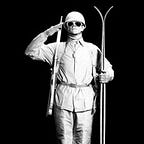Introduction | Part 1: Yosemite | Part 2: Yellowstone | Part 3: Olympic | Part 4: Glacier | Part 5: Grand Teton
WE HEAR IT BEFORE WE SEE IT. A small avalanche rumbles down the northeast flank of Mount Stimson, reeling over stepped cliff bands and stumbling down the bergschrund before coming to rest above the slumped crevasses of a dying, unnamed glacier. Even after recognizing the distinctive crack and roar of the slide, it takes a moment to locate its movement against the enormity of the overhead exposure; Stimson rises 4,000 vertical feet in three-quarters of a mile, with mercurial spines streaming from crumbling ridgelines like wind-tangled curtains. It’s Alaskan; it’s Alpen; it’s Andean — it’s huge.
Another 2,000 feet below my ski tips is our camp, situated along the undercut banks of Nyack Creek. We’ve spent four days getting here, skiing upstream with heavy sleds, all in order to stand below (and with luck, lay down tracks on) one of the largest, most remote, seldom visited faces in the Lower 48. We’ve crossed swollen rivers and bogs, fresh bear tracks the size of huckleberry pies, miles of dirt and rock and deadfall — all without a single turn to show for our efforts. But that’s the game in perhaps the greatest ski terrain that will never be popularized — Montana’s Glacier National Park.
The reason Glacier skiing won’t ever be popularized? Access is brutal. A few quality roadside shots hover above Marias Pass (on the park’s southern border), and Apgar has some low-angle touring, and once Going to the Sun Road opens midsummer there’s an annual flurry of slush-cupping at Logan Pass — all fun jaunts. But in midwinter, the dramatic high peaks for which Glacier is known, and the deep snowpack that until recently cultivated the park’s eponymous snowfields are harder to reach than almost any other point in the country. No roads penetrate the park in winter. No snowmobiles, helicopters, huts, or support. The very nature of the terrain, with huge vertical, low valleys, and choked forests, makes travel nearly impossible — unless you have skis. And so Glacier, which annually hosts nearly 2.5 million visitors, is simply given over to winter, when the vacancy holds extraordinary beauty and opportunity.
The recorded history of Glacier skiing is remarkably short and recent; the park has no historic ski culture or guidebooks specific to skiing. Locals Pete Costain and Andy Zimet first skied the striking southwest face of Stimson in 1997, which earned them recognition and GNP a place in the 2010 book, “Fifty Classic Ski Descents of North America.” Zimet also has the distinction of being the first person known to ski all six 10,000-foot peaks in the park — a project that took him 20 years to complete. Today, the area has a small but dedicated crew of locals who are quietly exploring the park on skis and putting new lines on the map, but midwinter trips are still immensely difficult and rare.
I remember a frigid night at Fishercap Lake near Many Glacier, when I crawled from my claustrophobic snow cave to discover lazy ice crystals suspended in the minus 20-degree atmosphere, reflecting pale blue moonlight like phosphorescent plankton against a pitted sea of dark peaks.
Another time, I skied across crisp grizzly tracks longer than my size-12 touring boots and nearly twice as wide. I vividly remember the prickles on my neck, the metallic taste of fear in my throat, and a similar moment when, not a half mile down the skin track, wolf prints the size of my hand joined the bear’s path.
Of course, few things compare to the satisfaction of lacing turns for thousands of feet down a mountain with no name, days from a road, knowing with reasonable certainty that no one has ever skied there before. Glacier is the wildest bit of the last frontier in Montana — and its rawness is palpable. The mountains here foster reverence.
It can’t go without saying though, that Glacier’s mystic magnetism is also tempered by the hard truth of changes known all too well by skiers. The glaciers are melting — nearly gone, actually. The small glacier below the northeast face of 10,141-foot Mount Stimson will vanish in a few short years — I’m glad to have seen it while I could. The rest of the glaciers in the park will be gone by 2030. Rain has begun falling higher and more often midwinter. The mountains are melting out earlier; rivers cresting sooner; fires burning longer, hotter. Still, beauty and wildness remain, and so does the skiing.
Here, sunsets make me fall in love and storms make me fall out, and succulent days pass without care for the effort I give. And on occasion, and with much luck, it’s possible to ski runs worthy of any effort. Skiing here takes more time and energy and desire than almost anywhere else. That day on Stimson? The small avalanche was the first of many as the peak warmed in the sun. After everything — the days, the miles, the bears — we watched the face crumble before our eyes and skied back to camp, unsuccessful, but not unfulfilled. That’s the point. That’s the game. That’s the price of admission to Glacier National Park.
EDITOR’S NOTE: Be sure to check out the film Monumental: Skiing Our National Parks, premiering October 20 in Denver, CO, followed by a nationwide tour. The film will be available to purchase online, as well. Additionally, POWDER produced a 150-page coffee-style hardcover book of the Monumental project. Go here for film, book, tour, and ticket information.
Read the Introduction and Parts 1–5 of Monumental: Skiing Our National Parks:
